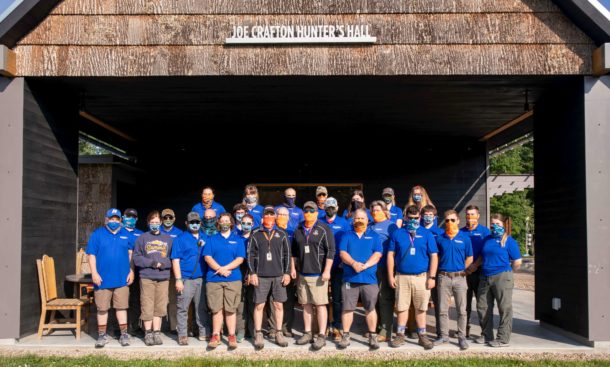For most adults, the notion of a tree house evokes nostalgia for a childhood of skinned knees and endless summers. But for Frank McCallister, a treehouse has become a way to pair technologies of the future with traditional Scouting values like conservation, thriftiness and efficiency.
“Sustainability will be one of the core principles as Scouting moves forward,” McCallister said Monday morning as campers and visitors browsed through the 125-foot steel and wooden structure known officially as the Summit Bechtel Reserve Sustainability Treehouse.
As teaching models go, the Sustainability Treehouse is quite innovative. The rustic-contemporary architecture of locally sourced woods and galvanized industrial metals seems perfectly situated among the greenery of the native white oaks and black locust that surround it. It’s four stories stretch vertically into the tree canopy, with a tilted solar panel deck jutting above that, recognizable from deep into Base Camps Alpha and Bravo.
And like a tree, the building itself gets its energy from the sun and recycles its water and waste.
A “water catchment system” on a roof near the entrance provides about 10,000 gallons of water per year. Two vertical wind turbines and the solar panel crank out about 35,000 kilowatts, enough to power three to five American homes for a year.
McCallister likes the idea that, like a tree, the building captures solar energy, catches wind, collects water and recycles it all — and does it quietly and without drama.
“This is a teaching facility. It’s a place where you can interact directly with Scouts, one on one. We need opportunities to cut through all the legal and political static that surrounds sustainability and get to what’s really important, which is innovation. We have to innovate.”
The Boy Scouts of America rolled out the Sustainability merit badge at the first Jamboree at the Summit in 2013. Scouts now must earn either Sustainability or Environmental Science merit badge on their journey to Eagle.
McCallister, whose family has made significant investments in the planning and construction of Summit Bechtel Reserve, believes Scouting is a natural fit for advancing sustainability concepts. Kids just gravitate toward new technologies, which are always evolving.
A former mining CEO who still gives a lot of energy and thought to the role of natural resources in the modern world, McCallister sees connections between the evolving needs of society and the materials we’ll need to meet those demands.
“It all circles back to our natural resources and how we think about them,” he said.
“When I was a boy I sat and watched the radio, that was our entertainment,” McCallister said.
“This generation doesn’t even watch TV; they watch their smart phone. And did you know there are 30 different natural elements in a smart phone?
“And the smart phone, like the human brain, is still developing. People will continue finding new ways to use it.”
McCallister thinks a lot about the future. He’s optimistic about the human capacity to innovate and adapt.
“We’re not using all our bandwidth.”



